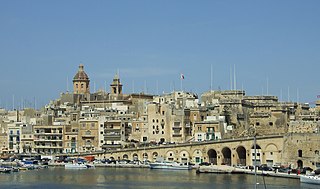
Birgu, also known by its title Città Vittoriosa, is an old fortified city on the south side of the Grand Harbour in the South Eastern Region of Malta. The city occupies a promontory of land with Fort Saint Angelo at its head and the city of Cospicua at its base. Birgu is ideally situated for safe anchorage, and over time it has developed a very long history with maritime, mercantile and military activities.

Victoria, also known among the native Maltese as Rabat or by its title Città Victoria, is an administrative unit of Malta, and the main town on Gozo,. Victoria has a total population of 6,901, and by population, is the largest locality in Gozo.

Żurrieq is a town in the Southern Region of Malta. It is one of the oldest towns in the country, and it has a population of 11,823 inhabitants as of March 2014. Żurrieq is one of the 10 parishes to be documented in 1436 and it is dedicated to Saint Catherine. The island of Filfla is administratively a part of the town. The town stretches from Nigret to Ħal Far. In old times the town was had a border with Żejtun. The village of Qrendi used to be part of the parish of Żurrieq until 1618 when it was made into its own parish.

St John's Co-Cathedral is a Roman Catholic co-cathedral in Valletta, Malta, dedicated to Saint John the Baptist. It was built by the Order of St. John between 1573 and 1578, having been commissioned by Grand Master Jean de la Cassière as the Conventual Church of Saint John.

Kalkara is a village in the South Eastern Region of Malta, with a population of 3,014 as of March 2014. The name is derived from the Latin word for lime (Calce), and it is believed that there was a lime kiln present there since Roman times. Kalkara forms part of the inner harbour area and occupies the area around Kalkara Creek. The town has its own Local Council and is bordered by the cities of Birgu and Żabbar, as well as the town of Xgħajra.

Gudja is a village in the Southern Region of Malta, with a population of 3,148 as of March 2017. The village is located on high grounds, south of Valletta. It is administered by the Gudja Local Council. A number of schools, clubs, public gardens and recreations places are found around the village.

Maltese architecture has its origins in prehistory, and some of the oldest free-standing structures on Earth – a series of megalithic temples – can be found on Malta. The islands were colonized by the Phoenicians and later the Romans, who established the cities of Melite and Gaulos. Although these were substantial settlements and are known to have had numerous temples, churches and palaces, few remains have survived apart from some architectural fragments.

Malta is for non-local government purposes divided into districts as opposed to the local government localities. The three main types of such districts – statistical, electoral at national level, and policing – have no mainstream administrative effect as the local councils form the first-tier – moreover only administrative tier – divisions of the country.

In the small Mediterranean island nation of Malta the predominant religion is Roman Catholicism.
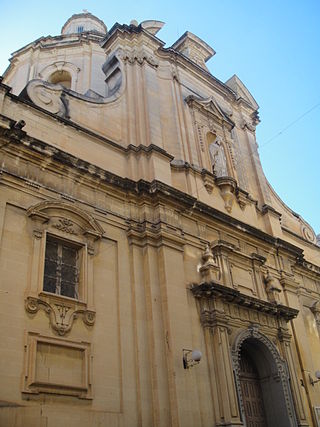
The Church of Saint Nicholas, also known as the Church of All Souls, is a Greek Catholic church in Valletta, Malta, dedicated to Saint Nicholas. Originally built as a Greek Orthodox church in 1569, it was conceded to the Confraternity of the Souls in Purgatory in 1639, who rebuilt the church in the Baroque style in 1652. The church was passed back to the Greek Catholic congregation in 2014 however the church is used from Ecumenical Patriarchate of Constantinople.
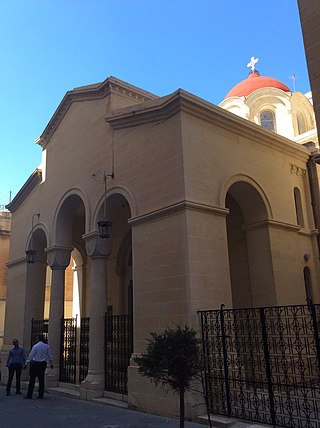
The Church of Our Lady of Damascus is a Catholic church in Valletta, in Malta, observing the Byzantine rite. It is also called Id-Damaxxena.

The Basilica of Our Lady of Mount Carmel is a Carmelite Roman Catholic minor basilica dedicated to Our Lady of Mount Carmel, located in Valletta, Malta. It is one of the major churches of Valletta, and it forms part of a UNESCO World Heritage Site which includes the entire city. The present church was constructed between 1958 and 1981 on the site of a late 16th century church which was destroyed during World War II.

St Catherine's Chapel officially the Church of St Catherine and St Peter is an 18th-century Roman Catholic church located in Mqabba, Malta.

The Parish Church of St Cajetan of Thiene is a Roman Catholic parish church in Ħamrun, Malta, dedicated to Saint Cajetan. The church was constructed between 1869 and 1875 to designs of Giorgio Costantino Schinas, in a combination of architectural styles. The oratory and dome were added later on in the 1890s and 1950s; the latter was designed by Andrea Vassallo and it was constructed under the direction of Ġużè Damato.
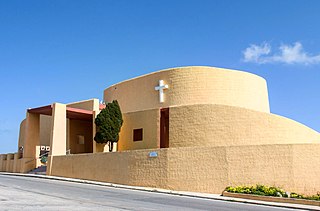
The Parish Church of Saint Joseph is an iconic Roman Catholic parish church in Manikata, Malta, dedicated to Saint Joseph. It was designed by Richard England in 1962, and it was built between 1964 and 1974. The church marks a break from traditional church building designs, and it is an example of Critical regionalism. Its form is inspired by the girna, a traditional corbelled stone hut.

The Chapel of Saint Mary of Ħal Tmin is a Roman Catholic 16th century chapel located in the outskirts of the village of Żejtun in Malta. Today the church remains in very good condition, with the teaching of catechism classes and other forms of religious activities and meetings organised in it. The chapel building is placed on the list of National Inventory of the Cultural Property of the Maltese Islands.

The Chapel of St Anne is a Roman Catholic chapel located in Fort Saint Elmo in Valletta, Malta. Its existence was first documented in the late 15th century, and it was incorporated into the fort when the latter was constructed by the Order of St John in the mid-16th century. The chapel's present state dates back to the mid-17th century.

The Church of Our Lady of Sorrows is a Roman Catholic church in Pietà, Malta. It was established in the late 16th or early 17th century near a cemetery in which victims of the 1592–1593 Malta plague epidemic were buried. It was originally dedicated to Saint Roch, but after a convent was built next to it in the early 17th century it was rededicated to Our Lady of Sorrows. The church later gave its name to the town of Pietà which developed nearby, and the present building dates back to the mid-18th century when it was reconstructed. Both the church and the convent are currently in the hands of a Catholic youth ministry.
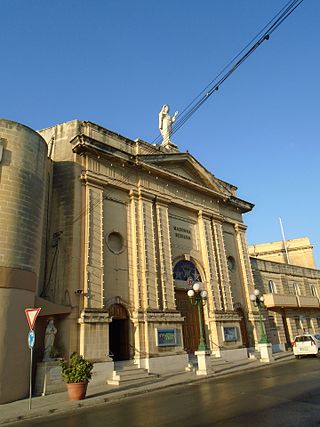
The Parish Church of the Immaculate Conception of Our Lady is a Roman Catholic parish church in Ħamrun, Malta. It was built between 1958 and 1963 and it took over the role of an oratory dedicated to the Immaculate Conception which had been established in Ħamrun in 1923. It has been a parish church since 1968.

St Catherine's Monastery is a monastery in Valletta, Malta which houses cloistered nuns of the Second Order of Saint Augustine. It incorporates the Church of the Presentation of Our Lady, which is more commonly known as the Church of St Catherine. The church and monastery were built in the 18th century and they replaced a previous monastery which had been housed in a 16th-century palace.





















